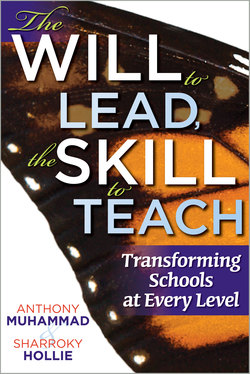Читать книгу Will to Lead, the Skill to Teach, The - Anthony Muhammad - Страница 5
На сайте Литреса книга снята с продажи.
ОглавлениеTable of Contents
About the Authors
PART I: WILL AND SKILL
Introduction
Will and Skill
The Blame Game
The “Turnaround” Concept
ONE
The Two Parts of a Positive School Environment
Will
Skill
The Four Zones of a Positive Learning Environment
The Need for Philosophical Agreement
Embracing Culture and Structure
PART II: THE WILL TO LEAD
TWO
Conflicting Wills
Schools as Microcosms
The Importance of a Healthy School Culture
Toxic School Culture
Collective Commitment to Success for All Students
Abolishing Conflicting Wills
THREE
Frustration in a Toxic Culture
Insufficient Preparation
Overwhelming Conditions
The Cycle of Blame
A Culture of Complaint
Doing to Students Versus Acting With Students
Lessening the Frustration
FOUR
The School Culture Framework: Creating a Culture of Collaboration
The Players
Believers and Fundamentalists
Collegial and Managerial Cultures
Reducing Fundamentalism
Building Up the Believers
Reversing Perceptions
FIVE
Leadership at Every Level
Transformational Leaders
Teacher Leaders
Site Leaders
Central and District Leaders
State and Federal Leaders
Building a Healthy Culture
PART III: THE SKILL TO TEACH
SIX
Developing a Responsive Pedagogy
Aligning the Will With the Skill
Skill Is Being Responsive
Three Lessons From Hollywood
Recognizing the Need for a Responsive Pedagogy
Identifying the Audience for Responsive Pedagogy
Beware of Deficit Thinking
Becoming Skillful
SEVEN
The Steps to a Responsive Pedagogy
Step One: Identify an Area of Instruction for Improvement
Step Two: Assess the Quantity and Quality of the Activities Currently Used
Step Three: Implement Responsive Activities During Teaching
The Art of Juxtapositions
Steps for Success
EIGHT
Responsive Classroom Management
Philosophies of Classroom Management
The Three P Approach
Activities for Responsive Classroom Management
Building Responsive Classroom Management
NINE
Responsive Academic Vocabulary
Four Key Premises
Steps for Responsive Vocabulary Instruction
Building Responsive Academic Vocabulary
TEN
Responsive Academic Literacy
Engaging Students With Culturally Responsive Texts
Using Read-Alouds in the Oral Tradition of Storytelling
Using Responsive Literacy Techniques Effectively
Building Responsive Academic Literacy
ELEVEN
Responsive Learning Environment
A Print-Rich Environment
Learning Centers
Culturally Colorful Materials
Optimally Arranged Space
Multiple Libraries
Technology
Relevant Bulletin Boards
Displayed Student Work and Images of Students
Building a Responsive Learning Environment
Afterword
References and Resources
Index
